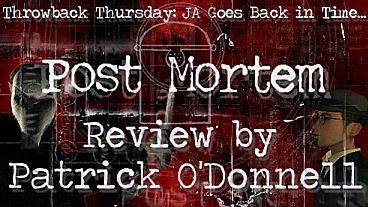
Throwback Thursday: Post Mortem – Review 1 of 2
 




Release Date: March 2003
Platform: PC
Note: Review originally published March 5, 2003
It’s a dark and rainy night in Paris. You are McPherson, an ex-P.I. who’s escaped the crime-ridden streets of New York and a mysterious past in order to take up a new life as an artist in the confines of a garret on the Left Bank. A troubled, beautiful woman knocks at your door, you have a horrific vision of two decapitated lovers in a blood-soaked bed, and you just know as you allow her to enter your room that you are in for a very bumpy ride through the shadows and hidden places of the City of Light.
Thus begins Post Mortem, a noir adventure-thriller that takes you from the exclusive hotels and five-star restaurants of Paris to back-street bistros, a cult headquarters, the bloody scene of the crime, and one of the best renditions of an insane asylum you’ll ever see in an adventure game. Post Mortem is a beautifully rendered, classic point-and-click adventure that allows smooth 360-degree panning of every location and multiple conversation paths with dozens of unique characters as you pick up the many clues that will allow you to solve a complex mystery with all the gothic and shady trappings one would expect of a Chandler or a Hammet.
There is a scattering of the usual puzzles—the dreaded tile puzzle (fortunately, not too obnoxious), the hackneyed newspaper-under-the-door-and-pencil-in-the-keyhole-trick to retrieve a key, an interesting alchemical conundrum or two, a fumbling with lockpicks—but the heart of the game lies in gathering the information and objects you’ll need to find out why an “innocent” American couple has been ritualistically murdered at a high-class Parisian hotel. Your skills as an artist are essential to solving the crime; the touch of clairvoyance that causes you to have visions and nightmares seems less crucial, but certainly adds to the mysterious and mystical atmosphere of the game. In short, all of the ingredients are in place for Post Mortem to be “as good as it gets” in the adventure game genre, and it’s published by Microids to boot, who gave us the wonderful Syberia not too long ago. Unlike Syberia, as should be clear by now, this one is not for the kids—there are some relatively graphic scenes of violence that rightly earn its “M” rating from the ESRB.
So what’s wrong with this picture? The trouble comes in Post Mortem when one recognizes that the game is something of an overachiever. In attempting to provide a few alternative routes through what is, primarily, a linear game, the developers put into place static conversation trees that have you, at certain points, asking questions about people, places, and objects you haven’t discovered yet because you visited location D out of five possible options before visiting location B. Nor are there sufficient indications along the way concerning what order you should follow in visiting or revisiting multiple sites as the game unfolds: mid-game, Post Mortem will not block you from visiting a restaurant where you ask questions about an ancient artifact before you have retrieved the clue in a dank apartment that provides you with sufficient details about the artifact so that you can even know what you are asking about. This leads to some serious confusion and the experience of a phenomenon I have never encountered in an adventure game—what might be called the “reverse red herring,” where a crucial detail seems irrelevant (rather than the other way around), or where you’re learning about things in a backwards fashion.
Combine this with some bad translations (Microids is a French company, and the game’s dialogues were clearly written in French first and then translated into English), and the game becomes something of a mess of false leads and fragmented clues. It all comes out in the end, but in order to finish you’ll have to traipse back and forth, Memento-like, trying to figure out what should have come first and last in any number of disorienting conversations. With patience you will get there, as long as you don’t mind a little pixel-hunting along the way, and stop often to enjoy the terrific visuals that Post Mortem has to offer.
Post Mortem is postmodern, I suppose—you’re awash in a sea of partial information that comes at you from all directions at inopportune times—but I don’t think this was intentional, and in any case it does not work in a game that in every other sense is fully enjoyable only if you can trace the correct linear path amidst branching options. The voice acting is passable; there’s a bit of repetitious bobbing and weaving of character’s faces in the attempt to match speech and gesture; but the stars here are atmosphere, eye candy, and the attempt—not always successful—to create a detective who is both an artist and a psychic. In the end, the game is good fun despite its flaws, and a real treat for the eyes. In a time when strong and appealing adventure games are at a premium, this one looks good and is worth a look.
Final Grade: B-
System Requirements:
Pentium II 350 MHz – Pentium III 500 MHz recommended
64 MB RAM – 128 MB recommended
16X CD-rom drive – 24X recommended
470 MB hard disk space
16 MB compatible Direct3D video card – 32 MB recommended
DirectX 7 compatible sound card

Leave a Reply